Article Critique Case Study 2022
VerifiedAdded on 2022/09/26
|10
|2740
|22
AI Summary
Contribute Materials
Your contribution can guide someone’s learning journey. Share your
documents today.
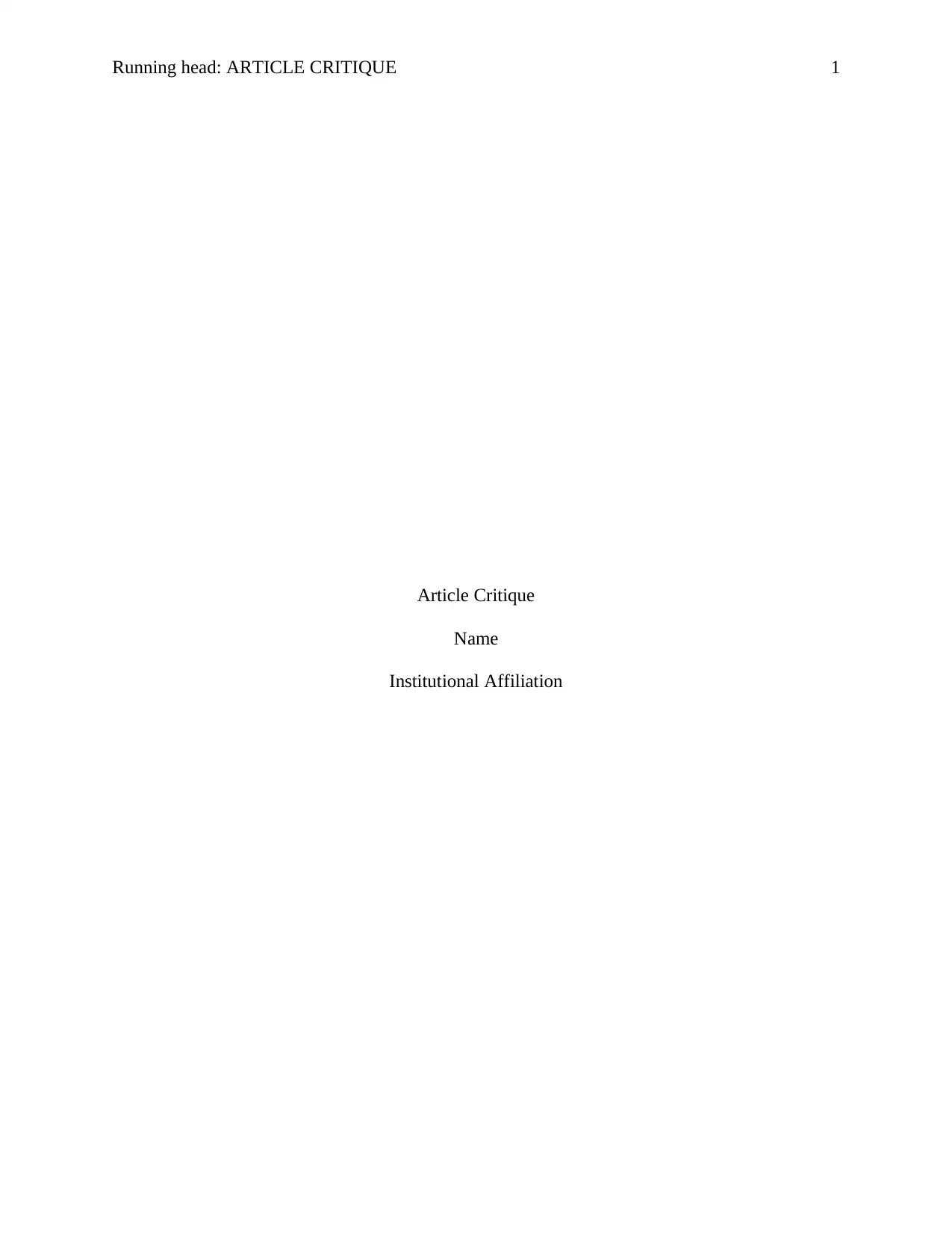
Running head: ARTICLE CRITIQUE 1
Article Critique
Name
Institutional Affiliation
Article Critique
Name
Institutional Affiliation
Secure Best Marks with AI Grader
Need help grading? Try our AI Grader for instant feedback on your assignments.
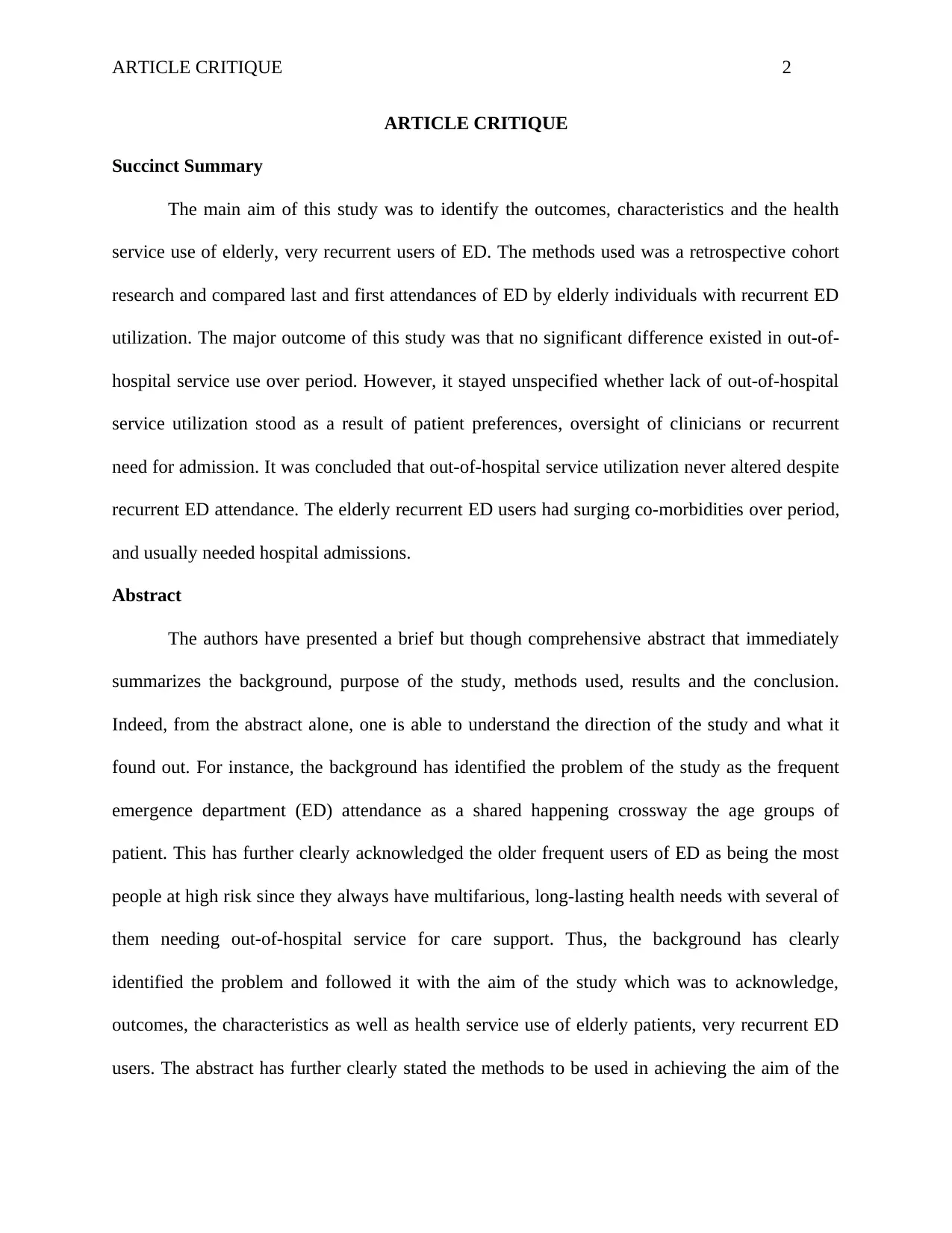
ARTICLE CRITIQUE 2
ARTICLE CRITIQUE
Succinct Summary
The main aim of this study was to identify the outcomes, characteristics and the health
service use of elderly, very recurrent users of ED. The methods used was a retrospective cohort
research and compared last and first attendances of ED by elderly individuals with recurrent ED
utilization. The major outcome of this study was that no significant difference existed in out-of-
hospital service use over period. However, it stayed unspecified whether lack of out-of-hospital
service utilization stood as a result of patient preferences, oversight of clinicians or recurrent
need for admission. It was concluded that out-of-hospital service utilization never altered despite
recurrent ED attendance. The elderly recurrent ED users had surging co-morbidities over period,
and usually needed hospital admissions.
Abstract
The authors have presented a brief but though comprehensive abstract that immediately
summarizes the background, purpose of the study, methods used, results and the conclusion.
Indeed, from the abstract alone, one is able to understand the direction of the study and what it
found out. For instance, the background has identified the problem of the study as the frequent
emergence department (ED) attendance as a shared happening crossway the age groups of
patient. This has further clearly acknowledged the older frequent users of ED as being the most
people at high risk since they always have multifarious, long-lasting health needs with several of
them needing out-of-hospital service for care support. Thus, the background has clearly
identified the problem and followed it with the aim of the study which was to acknowledge,
outcomes, the characteristics as well as health service use of elderly patients, very recurrent ED
users. The abstract has further clearly stated the methods to be used in achieving the aim of the
ARTICLE CRITIQUE
Succinct Summary
The main aim of this study was to identify the outcomes, characteristics and the health
service use of elderly, very recurrent users of ED. The methods used was a retrospective cohort
research and compared last and first attendances of ED by elderly individuals with recurrent ED
utilization. The major outcome of this study was that no significant difference existed in out-of-
hospital service use over period. However, it stayed unspecified whether lack of out-of-hospital
service utilization stood as a result of patient preferences, oversight of clinicians or recurrent
need for admission. It was concluded that out-of-hospital service utilization never altered despite
recurrent ED attendance. The elderly recurrent ED users had surging co-morbidities over period,
and usually needed hospital admissions.
Abstract
The authors have presented a brief but though comprehensive abstract that immediately
summarizes the background, purpose of the study, methods used, results and the conclusion.
Indeed, from the abstract alone, one is able to understand the direction of the study and what it
found out. For instance, the background has identified the problem of the study as the frequent
emergence department (ED) attendance as a shared happening crossway the age groups of
patient. This has further clearly acknowledged the older frequent users of ED as being the most
people at high risk since they always have multifarious, long-lasting health needs with several of
them needing out-of-hospital service for care support. Thus, the background has clearly
identified the problem and followed it with the aim of the study which was to acknowledge,
outcomes, the characteristics as well as health service use of elderly patients, very recurrent ED
users. The abstract has further clearly stated the methods to be used in achieving the aim of the
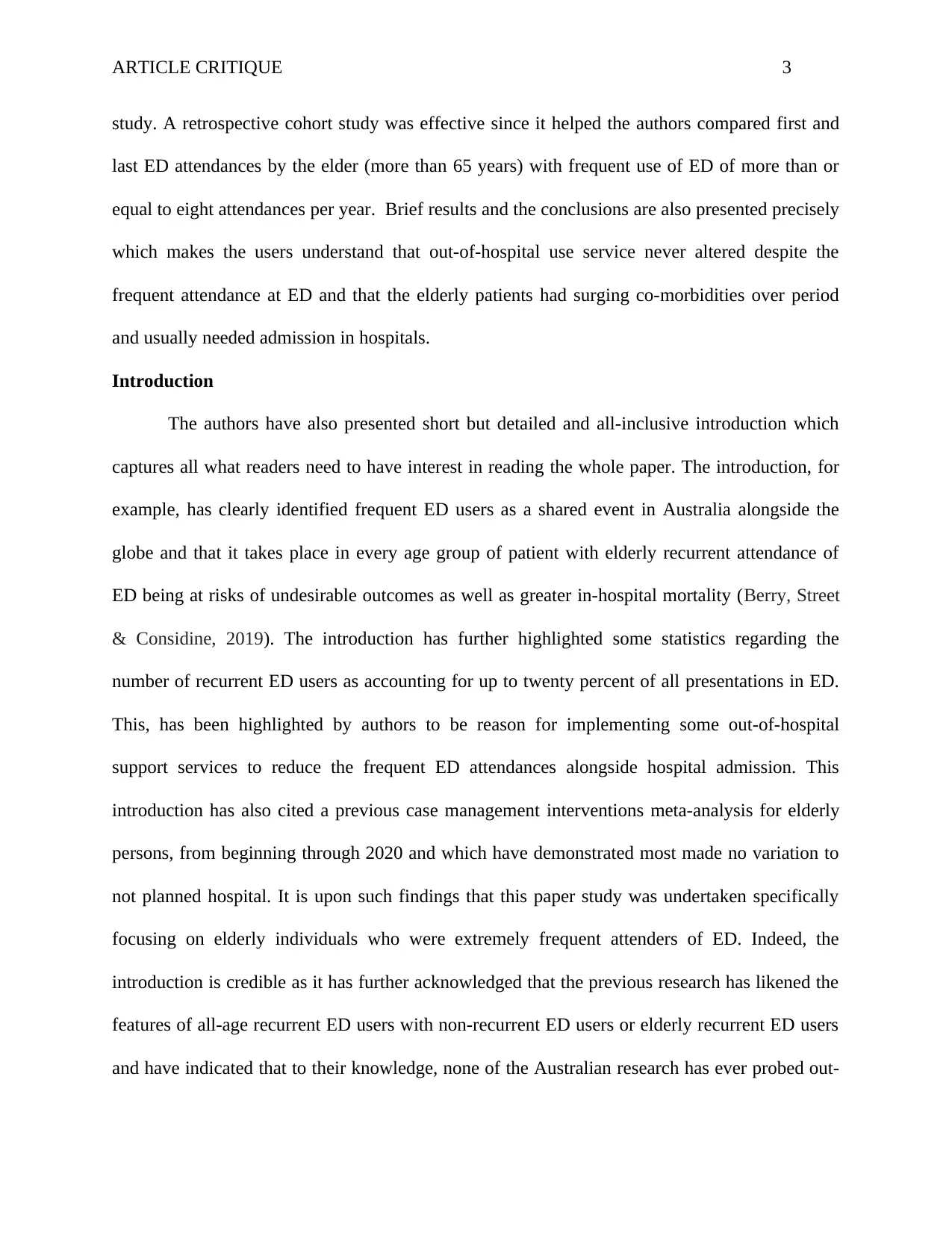
ARTICLE CRITIQUE 3
study. A retrospective cohort study was effective since it helped the authors compared first and
last ED attendances by the elder (more than 65 years) with frequent use of ED of more than or
equal to eight attendances per year. Brief results and the conclusions are also presented precisely
which makes the users understand that out-of-hospital use service never altered despite the
frequent attendance at ED and that the elderly patients had surging co-morbidities over period
and usually needed admission in hospitals.
Introduction
The authors have also presented short but detailed and all-inclusive introduction which
captures all what readers need to have interest in reading the whole paper. The introduction, for
example, has clearly identified frequent ED users as a shared event in Australia alongside the
globe and that it takes place in every age group of patient with elderly recurrent attendance of
ED being at risks of undesirable outcomes as well as greater in-hospital mortality (Berry, Street
& Considine, 2019). The introduction has further highlighted some statistics regarding the
number of recurrent ED users as accounting for up to twenty percent of all presentations in ED.
This, has been highlighted by authors to be reason for implementing some out-of-hospital
support services to reduce the frequent ED attendances alongside hospital admission. This
introduction has also cited a previous case management interventions meta-analysis for elderly
persons, from beginning through 2020 and which have demonstrated most made no variation to
not planned hospital. It is upon such findings that this paper study was undertaken specifically
focusing on elderly individuals who were extremely frequent attenders of ED. Indeed, the
introduction is credible as it has further acknowledged that the previous research has likened the
features of all-age recurrent ED users with non-recurrent ED users or elderly recurrent ED users
and have indicated that to their knowledge, none of the Australian research has ever probed out-
study. A retrospective cohort study was effective since it helped the authors compared first and
last ED attendances by the elder (more than 65 years) with frequent use of ED of more than or
equal to eight attendances per year. Brief results and the conclusions are also presented precisely
which makes the users understand that out-of-hospital use service never altered despite the
frequent attendance at ED and that the elderly patients had surging co-morbidities over period
and usually needed admission in hospitals.
Introduction
The authors have also presented short but detailed and all-inclusive introduction which
captures all what readers need to have interest in reading the whole paper. The introduction, for
example, has clearly identified frequent ED users as a shared event in Australia alongside the
globe and that it takes place in every age group of patient with elderly recurrent attendance of
ED being at risks of undesirable outcomes as well as greater in-hospital mortality (Berry, Street
& Considine, 2019). The introduction has further highlighted some statistics regarding the
number of recurrent ED users as accounting for up to twenty percent of all presentations in ED.
This, has been highlighted by authors to be reason for implementing some out-of-hospital
support services to reduce the frequent ED attendances alongside hospital admission. This
introduction has also cited a previous case management interventions meta-analysis for elderly
persons, from beginning through 2020 and which have demonstrated most made no variation to
not planned hospital. It is upon such findings that this paper study was undertaken specifically
focusing on elderly individuals who were extremely frequent attenders of ED. Indeed, the
introduction is credible as it has further acknowledged that the previous research has likened the
features of all-age recurrent ED users with non-recurrent ED users or elderly recurrent ED users
and have indicated that to their knowledge, none of the Australian research has ever probed out-
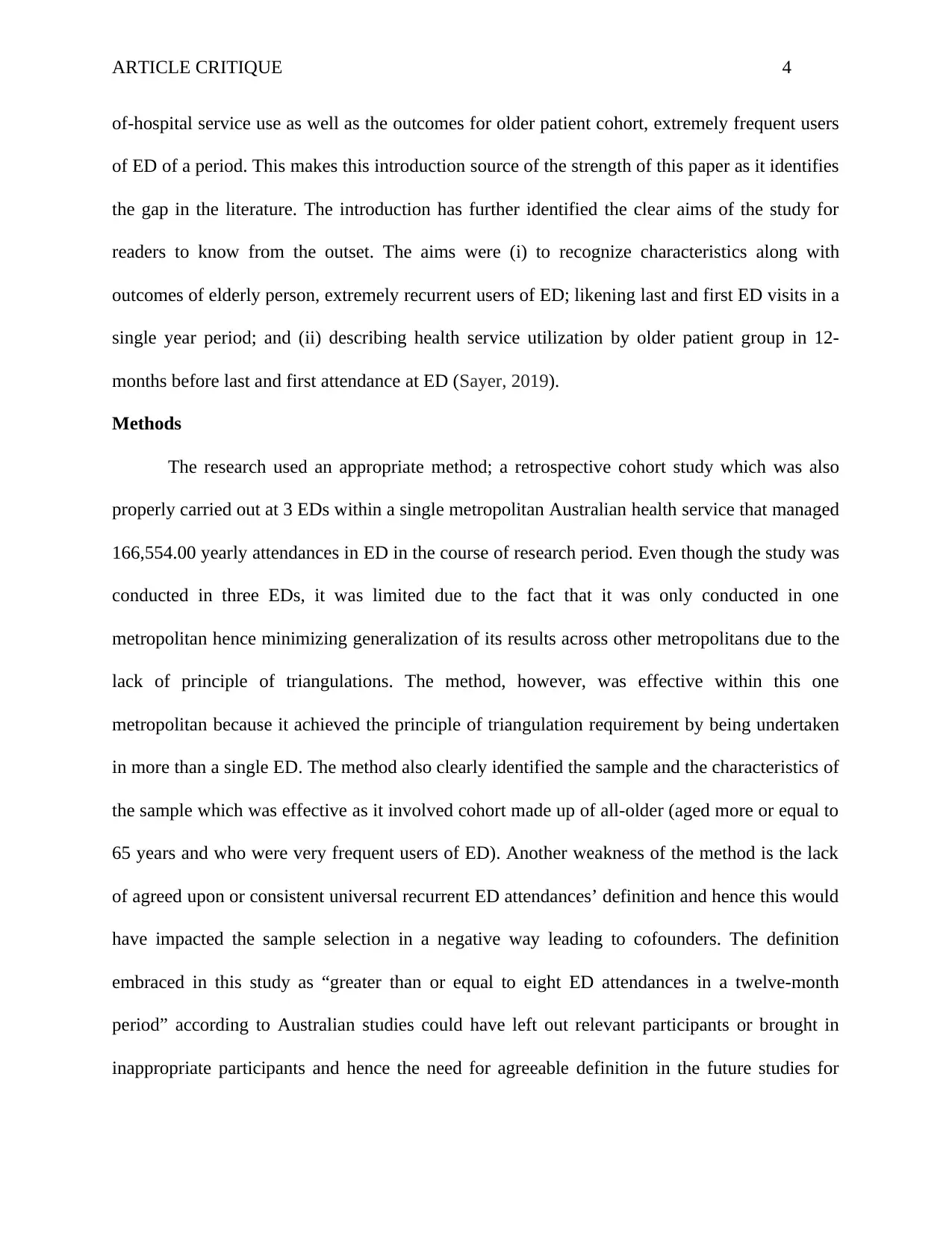
ARTICLE CRITIQUE 4
of-hospital service use as well as the outcomes for older patient cohort, extremely frequent users
of ED of a period. This makes this introduction source of the strength of this paper as it identifies
the gap in the literature. The introduction has further identified the clear aims of the study for
readers to know from the outset. The aims were (i) to recognize characteristics along with
outcomes of elderly person, extremely recurrent users of ED; likening last and first ED visits in a
single year period; and (ii) describing health service utilization by older patient group in 12-
months before last and first attendance at ED (Sayer, 2019).
Methods
The research used an appropriate method; a retrospective cohort study which was also
properly carried out at 3 EDs within a single metropolitan Australian health service that managed
166,554.00 yearly attendances in ED in the course of research period. Even though the study was
conducted in three EDs, it was limited due to the fact that it was only conducted in one
metropolitan hence minimizing generalization of its results across other metropolitans due to the
lack of principle of triangulations. The method, however, was effective within this one
metropolitan because it achieved the principle of triangulation requirement by being undertaken
in more than a single ED. The method also clearly identified the sample and the characteristics of
the sample which was effective as it involved cohort made up of all-older (aged more or equal to
65 years and who were very frequent users of ED). Another weakness of the method is the lack
of agreed upon or consistent universal recurrent ED attendances’ definition and hence this would
have impacted the sample selection in a negative way leading to cofounders. The definition
embraced in this study as “greater than or equal to eight ED attendances in a twelve-month
period” according to Australian studies could have left out relevant participants or brought in
inappropriate participants and hence the need for agreeable definition in the future studies for
of-hospital service use as well as the outcomes for older patient cohort, extremely frequent users
of ED of a period. This makes this introduction source of the strength of this paper as it identifies
the gap in the literature. The introduction has further identified the clear aims of the study for
readers to know from the outset. The aims were (i) to recognize characteristics along with
outcomes of elderly person, extremely recurrent users of ED; likening last and first ED visits in a
single year period; and (ii) describing health service utilization by older patient group in 12-
months before last and first attendance at ED (Sayer, 2019).
Methods
The research used an appropriate method; a retrospective cohort study which was also
properly carried out at 3 EDs within a single metropolitan Australian health service that managed
166,554.00 yearly attendances in ED in the course of research period. Even though the study was
conducted in three EDs, it was limited due to the fact that it was only conducted in one
metropolitan hence minimizing generalization of its results across other metropolitans due to the
lack of principle of triangulations. The method, however, was effective within this one
metropolitan because it achieved the principle of triangulation requirement by being undertaken
in more than a single ED. The method also clearly identified the sample and the characteristics of
the sample which was effective as it involved cohort made up of all-older (aged more or equal to
65 years and who were very frequent users of ED). Another weakness of the method is the lack
of agreed upon or consistent universal recurrent ED attendances’ definition and hence this would
have impacted the sample selection in a negative way leading to cofounders. The definition
embraced in this study as “greater than or equal to eight ED attendances in a twelve-month
period” according to Australian studies could have left out relevant participants or brought in
inappropriate participants and hence the need for agreeable definition in the future studies for
Secure Best Marks with AI Grader
Need help grading? Try our AI Grader for instant feedback on your assignments.
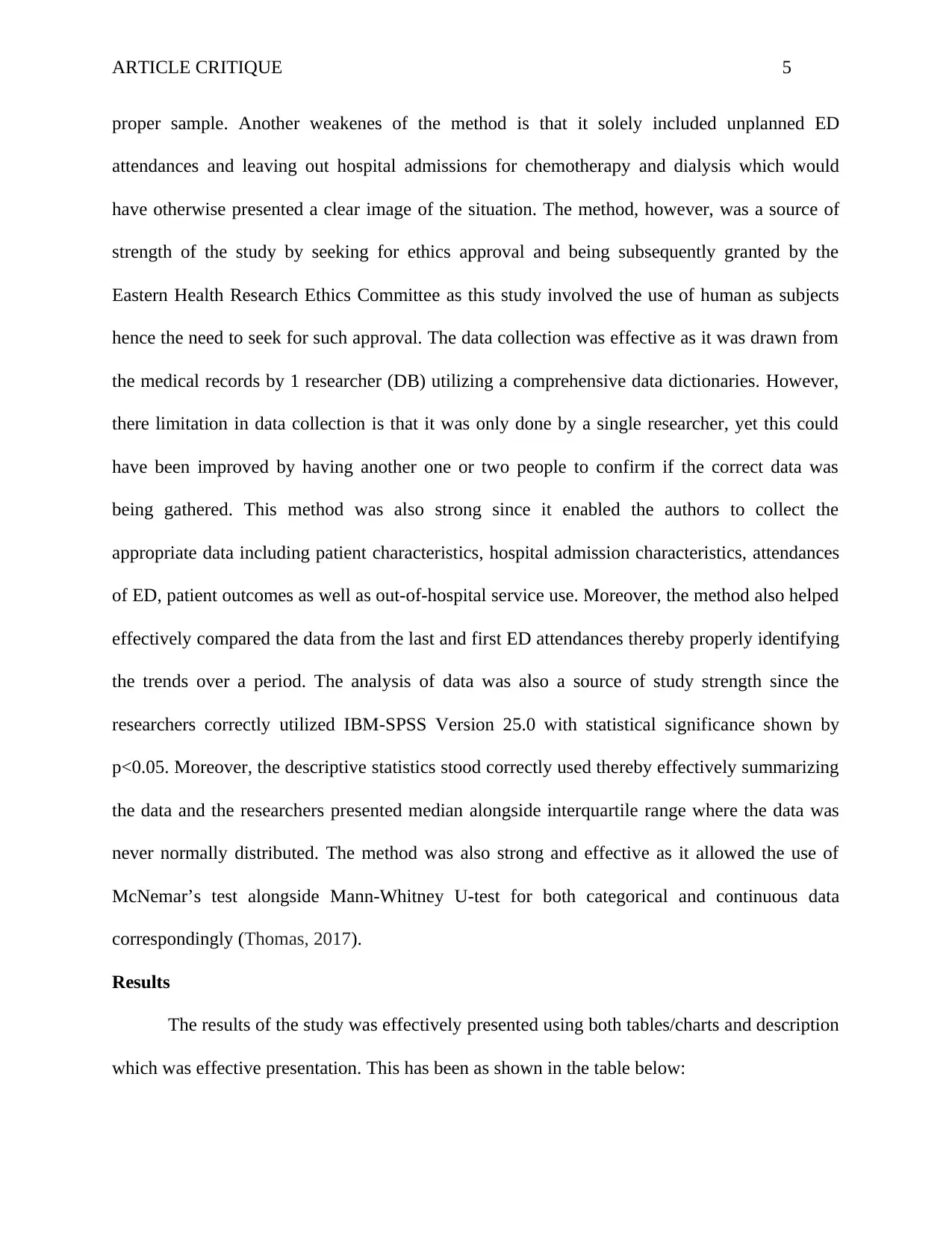
ARTICLE CRITIQUE 5
proper sample. Another weakenes of the method is that it solely included unplanned ED
attendances and leaving out hospital admissions for chemotherapy and dialysis which would
have otherwise presented a clear image of the situation. The method, however, was a source of
strength of the study by seeking for ethics approval and being subsequently granted by the
Eastern Health Research Ethics Committee as this study involved the use of human as subjects
hence the need to seek for such approval. The data collection was effective as it was drawn from
the medical records by 1 researcher (DB) utilizing a comprehensive data dictionaries. However,
there limitation in data collection is that it was only done by a single researcher, yet this could
have been improved by having another one or two people to confirm if the correct data was
being gathered. This method was also strong since it enabled the authors to collect the
appropriate data including patient characteristics, hospital admission characteristics, attendances
of ED, patient outcomes as well as out-of-hospital service use. Moreover, the method also helped
effectively compared the data from the last and first ED attendances thereby properly identifying
the trends over a period. The analysis of data was also a source of study strength since the
researchers correctly utilized IBM-SPSS Version 25.0 with statistical significance shown by
p<0.05. Moreover, the descriptive statistics stood correctly used thereby effectively summarizing
the data and the researchers presented median alongside interquartile range where the data was
never normally distributed. The method was also strong and effective as it allowed the use of
McNemar’s test alongside Mann-Whitney U-test for both categorical and continuous data
correspondingly (Thomas, 2017).
Results
The results of the study was effectively presented using both tables/charts and description
which was effective presentation. This has been as shown in the table below:
proper sample. Another weakenes of the method is that it solely included unplanned ED
attendances and leaving out hospital admissions for chemotherapy and dialysis which would
have otherwise presented a clear image of the situation. The method, however, was a source of
strength of the study by seeking for ethics approval and being subsequently granted by the
Eastern Health Research Ethics Committee as this study involved the use of human as subjects
hence the need to seek for such approval. The data collection was effective as it was drawn from
the medical records by 1 researcher (DB) utilizing a comprehensive data dictionaries. However,
there limitation in data collection is that it was only done by a single researcher, yet this could
have been improved by having another one or two people to confirm if the correct data was
being gathered. This method was also strong since it enabled the authors to collect the
appropriate data including patient characteristics, hospital admission characteristics, attendances
of ED, patient outcomes as well as out-of-hospital service use. Moreover, the method also helped
effectively compared the data from the last and first ED attendances thereby properly identifying
the trends over a period. The analysis of data was also a source of study strength since the
researchers correctly utilized IBM-SPSS Version 25.0 with statistical significance shown by
p<0.05. Moreover, the descriptive statistics stood correctly used thereby effectively summarizing
the data and the researchers presented median alongside interquartile range where the data was
never normally distributed. The method was also strong and effective as it allowed the use of
McNemar’s test alongside Mann-Whitney U-test for both categorical and continuous data
correspondingly (Thomas, 2017).
Results
The results of the study was effectively presented using both tables/charts and description
which was effective presentation. This has been as shown in the table below:
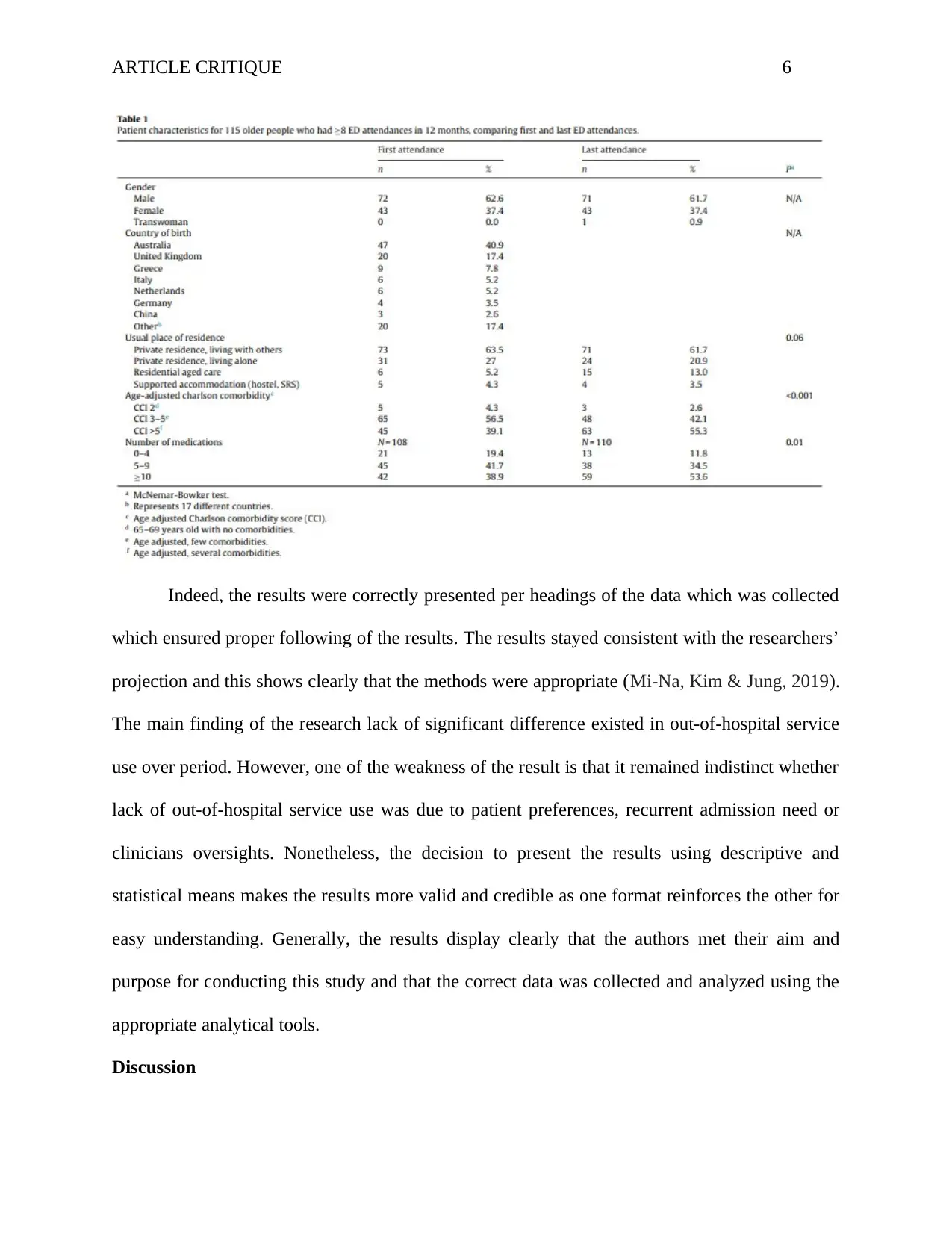
ARTICLE CRITIQUE 6
Indeed, the results were correctly presented per headings of the data which was collected
which ensured proper following of the results. The results stayed consistent with the researchers’
projection and this shows clearly that the methods were appropriate (Mi-Na, Kim & Jung, 2019).
The main finding of the research lack of significant difference existed in out-of-hospital service
use over period. However, one of the weakness of the result is that it remained indistinct whether
lack of out-of-hospital service use was due to patient preferences, recurrent admission need or
clinicians oversights. Nonetheless, the decision to present the results using descriptive and
statistical means makes the results more valid and credible as one format reinforces the other for
easy understanding. Generally, the results display clearly that the authors met their aim and
purpose for conducting this study and that the correct data was collected and analyzed using the
appropriate analytical tools.
Discussion
Indeed, the results were correctly presented per headings of the data which was collected
which ensured proper following of the results. The results stayed consistent with the researchers’
projection and this shows clearly that the methods were appropriate (Mi-Na, Kim & Jung, 2019).
The main finding of the research lack of significant difference existed in out-of-hospital service
use over period. However, one of the weakness of the result is that it remained indistinct whether
lack of out-of-hospital service use was due to patient preferences, recurrent admission need or
clinicians oversights. Nonetheless, the decision to present the results using descriptive and
statistical means makes the results more valid and credible as one format reinforces the other for
easy understanding. Generally, the results display clearly that the authors met their aim and
purpose for conducting this study and that the correct data was collected and analyzed using the
appropriate analytical tools.
Discussion
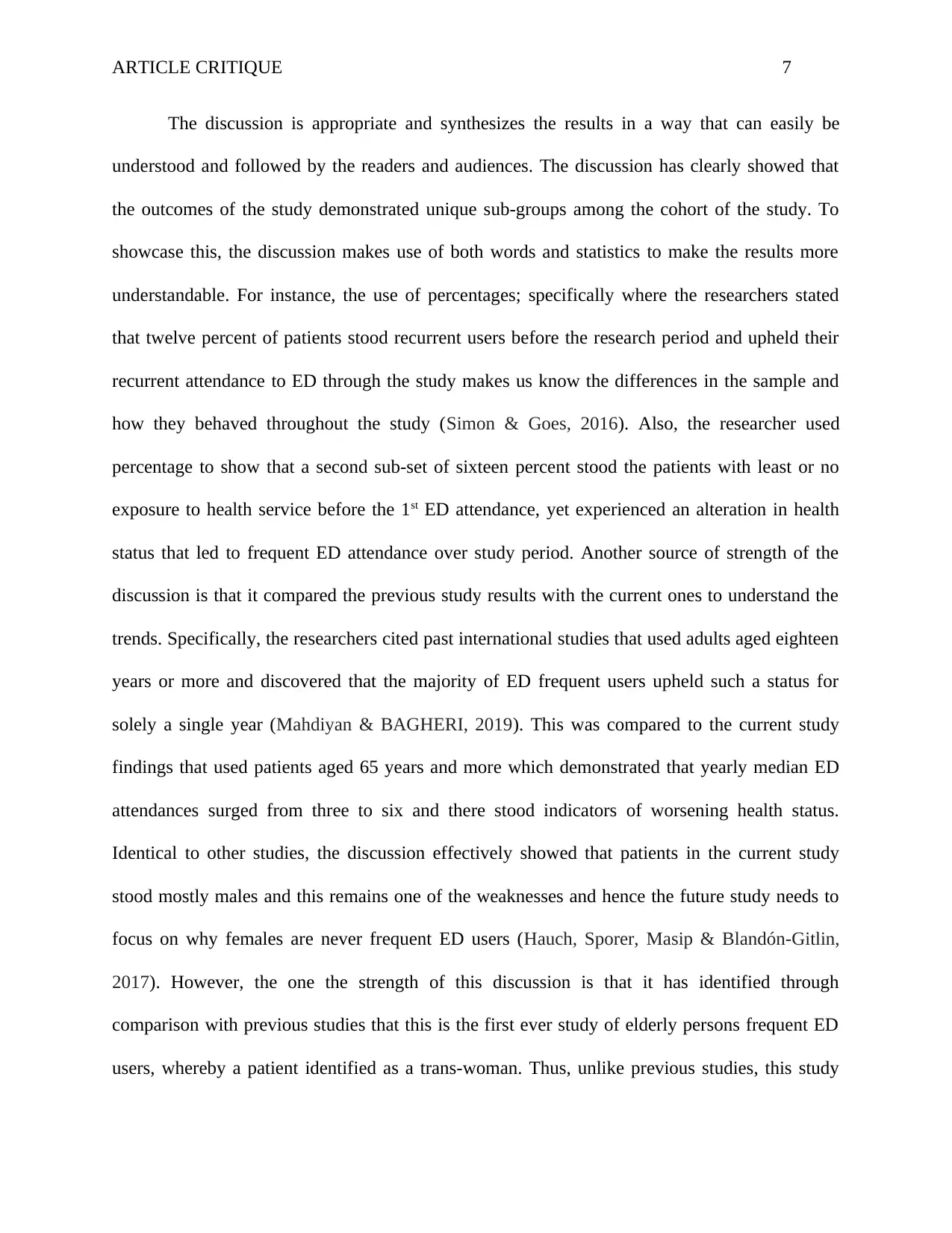
ARTICLE CRITIQUE 7
The discussion is appropriate and synthesizes the results in a way that can easily be
understood and followed by the readers and audiences. The discussion has clearly showed that
the outcomes of the study demonstrated unique sub-groups among the cohort of the study. To
showcase this, the discussion makes use of both words and statistics to make the results more
understandable. For instance, the use of percentages; specifically where the researchers stated
that twelve percent of patients stood recurrent users before the research period and upheld their
recurrent attendance to ED through the study makes us know the differences in the sample and
how they behaved throughout the study (Simon & Goes, 2016). Also, the researcher used
percentage to show that a second sub-set of sixteen percent stood the patients with least or no
exposure to health service before the 1st ED attendance, yet experienced an alteration in health
status that led to frequent ED attendance over study period. Another source of strength of the
discussion is that it compared the previous study results with the current ones to understand the
trends. Specifically, the researchers cited past international studies that used adults aged eighteen
years or more and discovered that the majority of ED frequent users upheld such a status for
solely a single year (Mahdiyan & BAGHERI, 2019). This was compared to the current study
findings that used patients aged 65 years and more which demonstrated that yearly median ED
attendances surged from three to six and there stood indicators of worsening health status.
Identical to other studies, the discussion effectively showed that patients in the current study
stood mostly males and this remains one of the weaknesses and hence the future study needs to
focus on why females are never frequent ED users (Hauch, Sporer, Masip & Blandón-Gitlin,
2017). However, the one the strength of this discussion is that it has identified through
comparison with previous studies that this is the first ever study of elderly persons frequent ED
users, whereby a patient identified as a trans-woman. Thus, unlike previous studies, this study
The discussion is appropriate and synthesizes the results in a way that can easily be
understood and followed by the readers and audiences. The discussion has clearly showed that
the outcomes of the study demonstrated unique sub-groups among the cohort of the study. To
showcase this, the discussion makes use of both words and statistics to make the results more
understandable. For instance, the use of percentages; specifically where the researchers stated
that twelve percent of patients stood recurrent users before the research period and upheld their
recurrent attendance to ED through the study makes us know the differences in the sample and
how they behaved throughout the study (Simon & Goes, 2016). Also, the researcher used
percentage to show that a second sub-set of sixteen percent stood the patients with least or no
exposure to health service before the 1st ED attendance, yet experienced an alteration in health
status that led to frequent ED attendance over study period. Another source of strength of the
discussion is that it compared the previous study results with the current ones to understand the
trends. Specifically, the researchers cited past international studies that used adults aged eighteen
years or more and discovered that the majority of ED frequent users upheld such a status for
solely a single year (Mahdiyan & BAGHERI, 2019). This was compared to the current study
findings that used patients aged 65 years and more which demonstrated that yearly median ED
attendances surged from three to six and there stood indicators of worsening health status.
Identical to other studies, the discussion effectively showed that patients in the current study
stood mostly males and this remains one of the weaknesses and hence the future study needs to
focus on why females are never frequent ED users (Hauch, Sporer, Masip & Blandón-Gitlin,
2017). However, the one the strength of this discussion is that it has identified through
comparison with previous studies that this is the first ever study of elderly persons frequent ED
users, whereby a patient identified as a trans-woman. Thus, unlike previous studies, this study
Paraphrase This Document
Need a fresh take? Get an instant paraphrase of this document with our AI Paraphraser
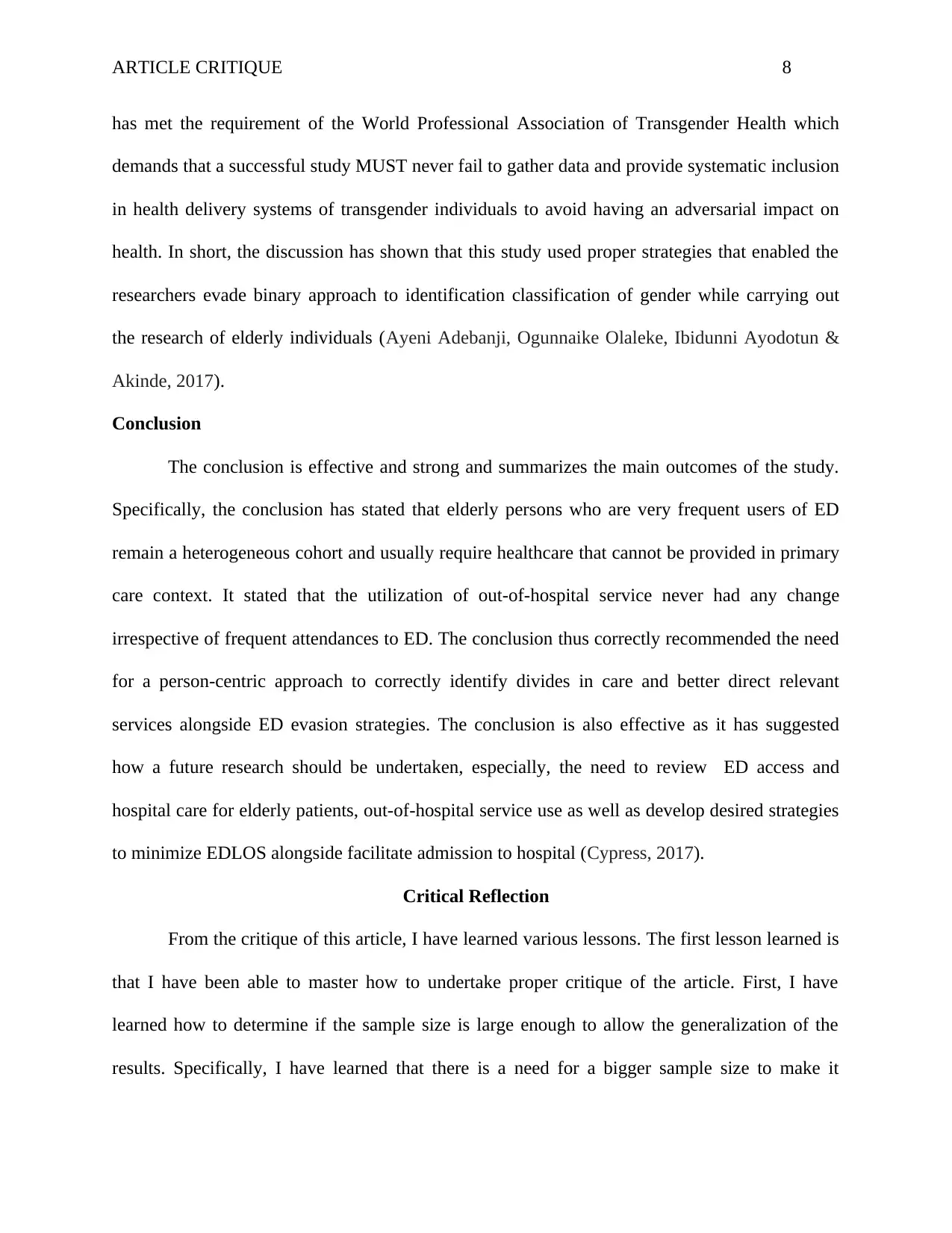
ARTICLE CRITIQUE 8
has met the requirement of the World Professional Association of Transgender Health which
demands that a successful study MUST never fail to gather data and provide systematic inclusion
in health delivery systems of transgender individuals to avoid having an adversarial impact on
health. In short, the discussion has shown that this study used proper strategies that enabled the
researchers evade binary approach to identification classification of gender while carrying out
the research of elderly individuals (Ayeni Adebanji, Ogunnaike Olaleke, Ibidunni Ayodotun &
Akinde, 2017).
Conclusion
The conclusion is effective and strong and summarizes the main outcomes of the study.
Specifically, the conclusion has stated that elderly persons who are very frequent users of ED
remain a heterogeneous cohort and usually require healthcare that cannot be provided in primary
care context. It stated that the utilization of out-of-hospital service never had any change
irrespective of frequent attendances to ED. The conclusion thus correctly recommended the need
for a person-centric approach to correctly identify divides in care and better direct relevant
services alongside ED evasion strategies. The conclusion is also effective as it has suggested
how a future research should be undertaken, especially, the need to review ED access and
hospital care for elderly patients, out-of-hospital service use as well as develop desired strategies
to minimize EDLOS alongside facilitate admission to hospital (Cypress, 2017).
Critical Reflection
From the critique of this article, I have learned various lessons. The first lesson learned is
that I have been able to master how to undertake proper critique of the article. First, I have
learned how to determine if the sample size is large enough to allow the generalization of the
results. Specifically, I have learned that there is a need for a bigger sample size to make it
has met the requirement of the World Professional Association of Transgender Health which
demands that a successful study MUST never fail to gather data and provide systematic inclusion
in health delivery systems of transgender individuals to avoid having an adversarial impact on
health. In short, the discussion has shown that this study used proper strategies that enabled the
researchers evade binary approach to identification classification of gender while carrying out
the research of elderly individuals (Ayeni Adebanji, Ogunnaike Olaleke, Ibidunni Ayodotun &
Akinde, 2017).
Conclusion
The conclusion is effective and strong and summarizes the main outcomes of the study.
Specifically, the conclusion has stated that elderly persons who are very frequent users of ED
remain a heterogeneous cohort and usually require healthcare that cannot be provided in primary
care context. It stated that the utilization of out-of-hospital service never had any change
irrespective of frequent attendances to ED. The conclusion thus correctly recommended the need
for a person-centric approach to correctly identify divides in care and better direct relevant
services alongside ED evasion strategies. The conclusion is also effective as it has suggested
how a future research should be undertaken, especially, the need to review ED access and
hospital care for elderly patients, out-of-hospital service use as well as develop desired strategies
to minimize EDLOS alongside facilitate admission to hospital (Cypress, 2017).
Critical Reflection
From the critique of this article, I have learned various lessons. The first lesson learned is
that I have been able to master how to undertake proper critique of the article. First, I have
learned how to determine if the sample size is large enough to allow the generalization of the
results. Specifically, I have learned that there is a need for a bigger sample size to make it
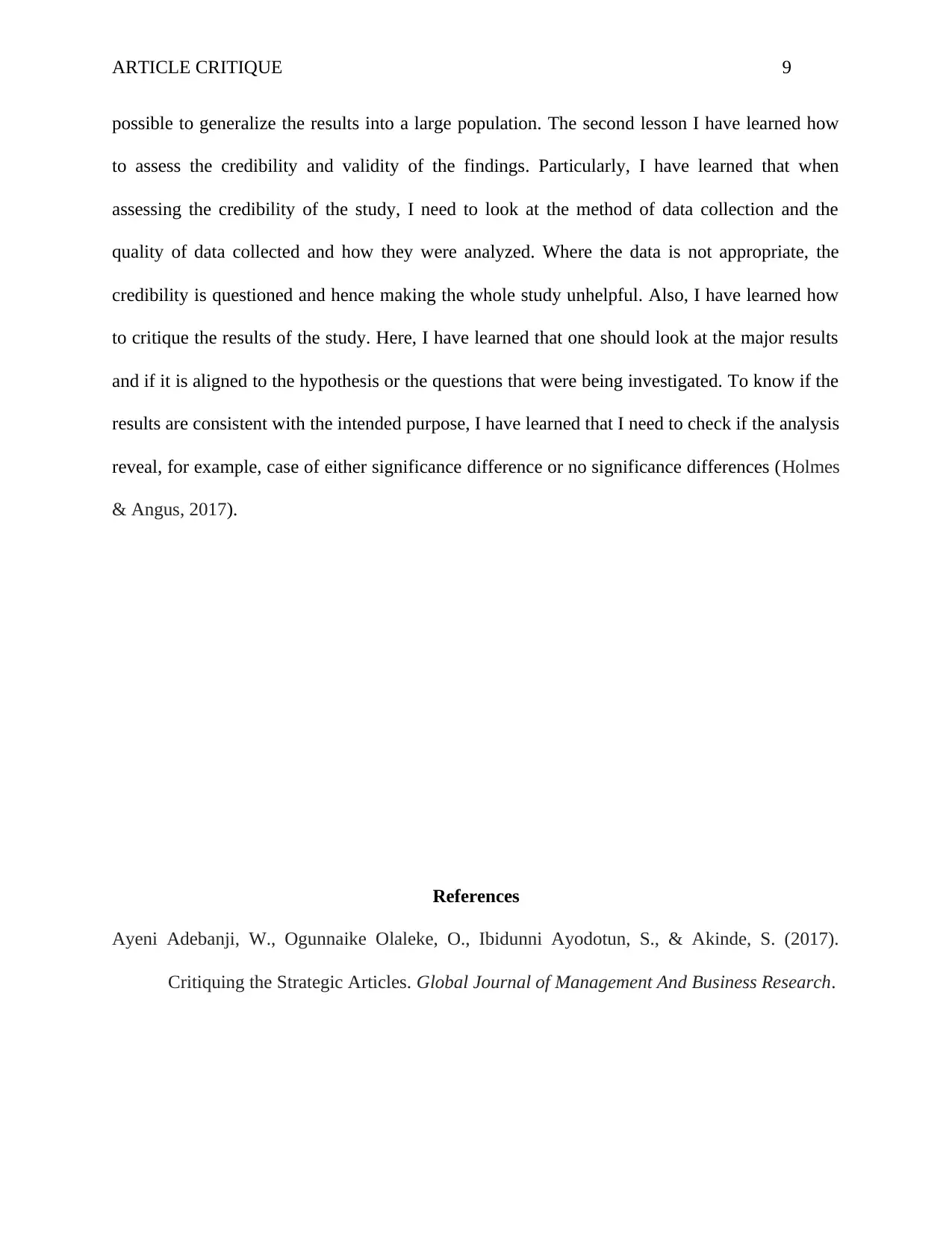
ARTICLE CRITIQUE 9
possible to generalize the results into a large population. The second lesson I have learned how
to assess the credibility and validity of the findings. Particularly, I have learned that when
assessing the credibility of the study, I need to look at the method of data collection and the
quality of data collected and how they were analyzed. Where the data is not appropriate, the
credibility is questioned and hence making the whole study unhelpful. Also, I have learned how
to critique the results of the study. Here, I have learned that one should look at the major results
and if it is aligned to the hypothesis or the questions that were being investigated. To know if the
results are consistent with the intended purpose, I have learned that I need to check if the analysis
reveal, for example, case of either significance difference or no significance differences (Holmes
& Angus, 2017).
References
Ayeni Adebanji, W., Ogunnaike Olaleke, O., Ibidunni Ayodotun, S., & Akinde, S. (2017).
Critiquing the Strategic Articles. Global Journal of Management And Business Research.
possible to generalize the results into a large population. The second lesson I have learned how
to assess the credibility and validity of the findings. Particularly, I have learned that when
assessing the credibility of the study, I need to look at the method of data collection and the
quality of data collected and how they were analyzed. Where the data is not appropriate, the
credibility is questioned and hence making the whole study unhelpful. Also, I have learned how
to critique the results of the study. Here, I have learned that one should look at the major results
and if it is aligned to the hypothesis or the questions that were being investigated. To know if the
results are consistent with the intended purpose, I have learned that I need to check if the analysis
reveal, for example, case of either significance difference or no significance differences (Holmes
& Angus, 2017).
References
Ayeni Adebanji, W., Ogunnaike Olaleke, O., Ibidunni Ayodotun, S., & Akinde, S. (2017).
Critiquing the Strategic Articles. Global Journal of Management And Business Research.
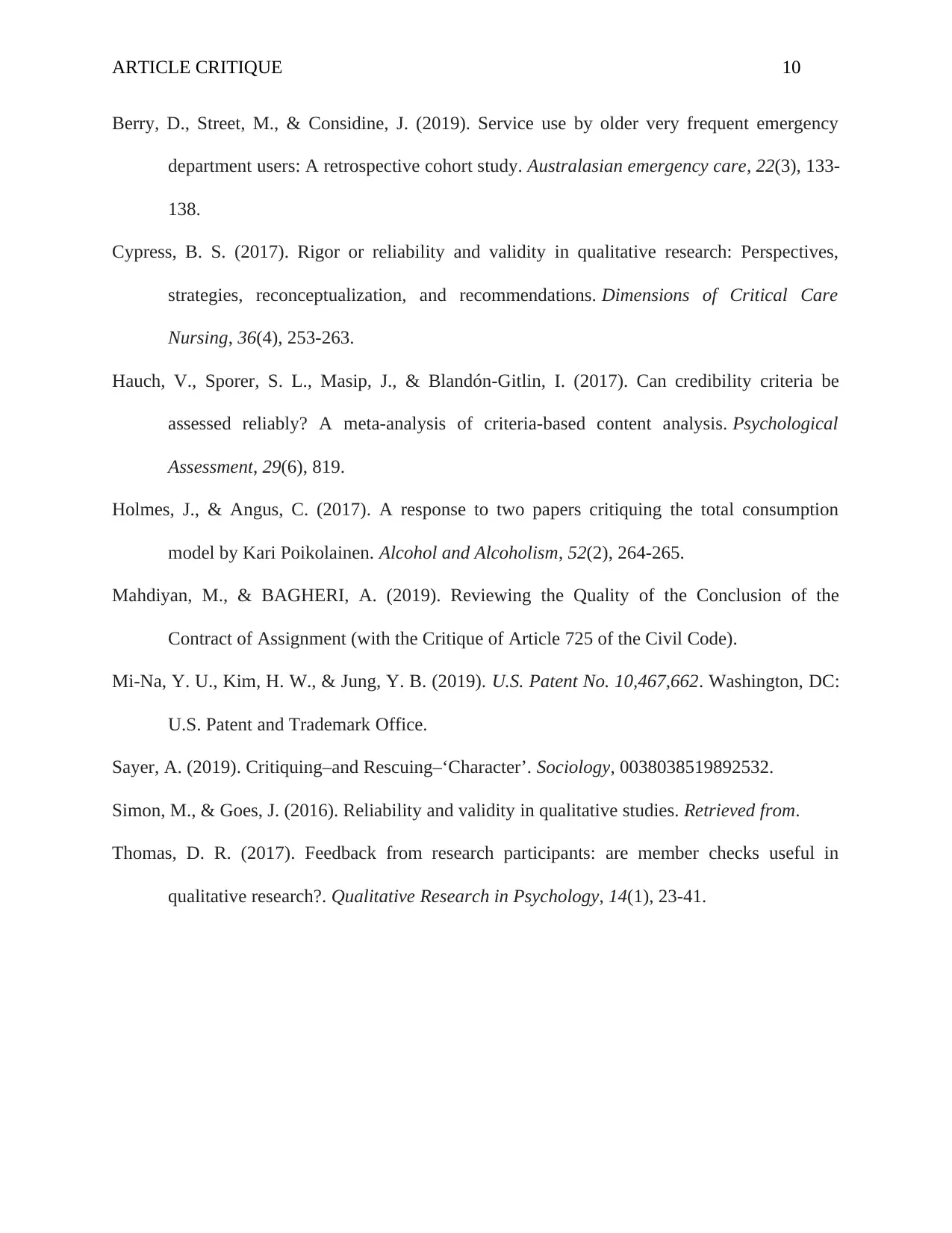
ARTICLE CRITIQUE 10
Berry, D., Street, M., & Considine, J. (2019). Service use by older very frequent emergency
department users: A retrospective cohort study. Australasian emergency care, 22(3), 133-
138.
Cypress, B. S. (2017). Rigor or reliability and validity in qualitative research: Perspectives,
strategies, reconceptualization, and recommendations. Dimensions of Critical Care
Nursing, 36(4), 253-263.
Hauch, V., Sporer, S. L., Masip, J., & Blandón-Gitlin, I. (2017). Can credibility criteria be
assessed reliably? A meta-analysis of criteria-based content analysis. Psychological
Assessment, 29(6), 819.
Holmes, J., & Angus, C. (2017). A response to two papers critiquing the total consumption
model by Kari Poikolainen. Alcohol and Alcoholism, 52(2), 264-265.
Mahdiyan, M., & BAGHERI, A. (2019). Reviewing the Quality of the Conclusion of the
Contract of Assignment (with the Critique of Article 725 of the Civil Code).
Mi-Na, Y. U., Kim, H. W., & Jung, Y. B. (2019). U.S. Patent No. 10,467,662. Washington, DC:
U.S. Patent and Trademark Office.
Sayer, A. (2019). Critiquing–and Rescuing–‘Character’. Sociology, 0038038519892532.
Simon, M., & Goes, J. (2016). Reliability and validity in qualitative studies. Retrieved from.
Thomas, D. R. (2017). Feedback from research participants: are member checks useful in
qualitative research?. Qualitative Research in Psychology, 14(1), 23-41.
Berry, D., Street, M., & Considine, J. (2019). Service use by older very frequent emergency
department users: A retrospective cohort study. Australasian emergency care, 22(3), 133-
138.
Cypress, B. S. (2017). Rigor or reliability and validity in qualitative research: Perspectives,
strategies, reconceptualization, and recommendations. Dimensions of Critical Care
Nursing, 36(4), 253-263.
Hauch, V., Sporer, S. L., Masip, J., & Blandón-Gitlin, I. (2017). Can credibility criteria be
assessed reliably? A meta-analysis of criteria-based content analysis. Psychological
Assessment, 29(6), 819.
Holmes, J., & Angus, C. (2017). A response to two papers critiquing the total consumption
model by Kari Poikolainen. Alcohol and Alcoholism, 52(2), 264-265.
Mahdiyan, M., & BAGHERI, A. (2019). Reviewing the Quality of the Conclusion of the
Contract of Assignment (with the Critique of Article 725 of the Civil Code).
Mi-Na, Y. U., Kim, H. W., & Jung, Y. B. (2019). U.S. Patent No. 10,467,662. Washington, DC:
U.S. Patent and Trademark Office.
Sayer, A. (2019). Critiquing–and Rescuing–‘Character’. Sociology, 0038038519892532.
Simon, M., & Goes, J. (2016). Reliability and validity in qualitative studies. Retrieved from.
Thomas, D. R. (2017). Feedback from research participants: are member checks useful in
qualitative research?. Qualitative Research in Psychology, 14(1), 23-41.
1 out of 10
Your All-in-One AI-Powered Toolkit for Academic Success.
+13062052269
info@desklib.com
Available 24*7 on WhatsApp / Email
![[object Object]](/_next/static/media/star-bottom.7253800d.svg)
Unlock your academic potential
© 2024 | Zucol Services PVT LTD | All rights reserved.


